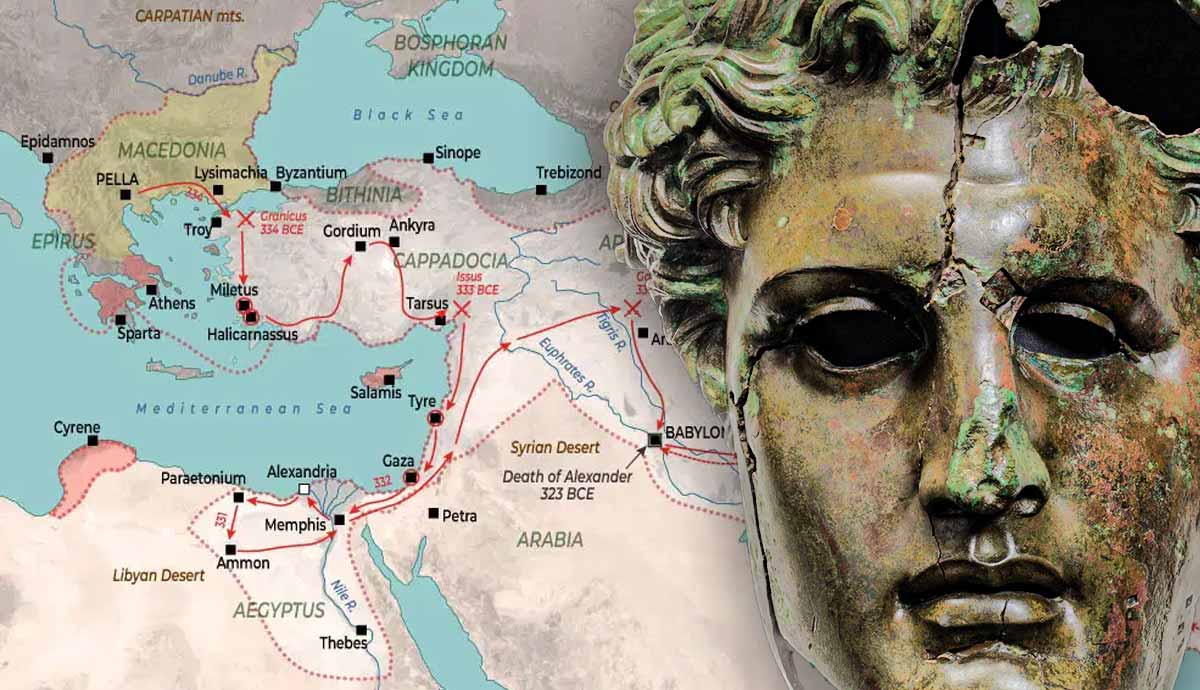
In 259 BCE, there was no China. There was no unified group of people to call themselves “Chinese,” there was no empire, and certainly, there was no Chinese emperor. Indeed, in 259 BCE, the year that Ying Zheng, the man who became China’s first emperor, was born, there was only a group of warring states clustered around the Yellow River. How did this seemingly inconsequential figure become one of the most pivotal monarchs in human history? And how did he unite the warring states to achieve his dream of a unified China?
Before China: The Warring States Period

The Warring States period, as it is now known, was an era of bitter and bloody military rivalry that lasted for over two centuries. The turbulent period came to an end when the victorious state of Qin was finally able to conquer its six rival states and unify them under one centralized power to establish the Qin (or “Ch’in”) dynasty, from which modern China takes its Western name. But before Ying Zheng could become the first Chinese emperor, he was a mere prince from the ostensibly rough and inhospitable place on the western periphery of this collection of warring states.
The first Chinese emperor’s home state of Qin was generally considered culturally inferior to the other kingdoms, being somewhat geographically isolated and seemingly having more in common with the nomadic tribes that inhabited the regions to its western borders, with whom Qin often fought. A prince from the neighboring state of Wei once derided Qin as a “rough and crude place” that “knows nothing about virtuous conduct.” So how did Ying Zheng, a prince from this so-called coarse and unsophisticated land on the edge of the “civilized” world, come to become China’s first emperor? To answer that, we must first go back another 100 years to the center of Qin’s defining philosophy.
Legalism & the Making of the Qin State

To understand what set the state of Qin apart from its rivals, we must first understand what made the state tick, the ideology that underpinned the state’s culture, and ultimately its success. The first Chinese emperor’s success in unifying the warring states appears to be largely a result of his state’s fundamental core of Legalism. Qin’s political and social systems, coupled with its culture of military prowess, made it possible for one of its rulers to conquer the neighboring kingdoms.
By the time Ying Zheng ascended the throne of Qin in 246 BCE, the state had long since contorted itself into a system of ruthless authoritarianism, prizing military success above all. These values had been imposed on Qin through the reforms of Shang Yang, whose ideology centered primarily around cold-blooded pragmatism. Shang dismissed the Confucian principles of righteousness, benevolence, and propriety favored by the other states. Instead, he replaced them with the one principle and only virtue that he recognized: the centralization of state power, by any means necessary.
Under the influence of Shang Yang, Qin hardened itself. Like a Chinese Sparta, its every move was calculated to ensure a richer state, productive agriculture, and stronger army. And though (as the other states often pointed out) Qin seemed somewhat less culturally advanced than its rivals, this apparent weakness would prove a crucial advantage.
Without the focus on the arts, etiquette, and decorum, Qin could concentrate on becoming a military powerhouse. It cultivated a system that established a new aristocratic structure: a meritocracy that rewarded officials for their military success instead of the old system of inherited power and influence.

Social rank and status solely reflected military performance. Military service for the general populace was mandatory. All men were required to serve in the army, and women too were expected to participate in war if their town or city came under attack. Qin’s superior military system and mobilization of its population were no doubt at the bottom of ensuring its success in annexing the other states.
Meanwhile, a rigid Legalist system of rewards and punishments tightened state control over the Qin people. Shang endorsed the view that the only way to rule was to frighten the countrymen into submission: to entice, terrify, reward, and punish. And the punishments were severe. Take, for instance, this account given by Han Fei (a follower of Shang Yang’s): “anyone who failed to report criminal activity would be chopped in two at the waist.” Such was the severity of Qin law–there would be no mercy, even for the innocent onlooker that simply failed to snitch.
To Shang’s credit, this brutal system of law enforcement appeared to work; by the third century BCE, the people of Qin seemed to be remarkably law-abiding (somewhat unsurprisingly, given the punishments), agricultural production had increased, and direct taxation was bringing substantial revenue to the state. This solid bedrock of social, economic, and agricultural cohesion allowed Qin to cultivate its superior military. As the Marquis Wu of Wei conceded, “Qin’s nature is strong. Its government is severe. Its rewards and punishments are decisive. Its people do not yield.” The other states did not know half of it; at least, not yet.
Becoming Qin Shi Huangdi: The Unification of China

In 230 BCE, Ying Zheng ascended the throne, and over the next decade, he unleashed the full force of Qin’s military might on the remaining independent states. One by one, the warring states fell under Qin control. With the help of his chancellor Li Si and general Meng Tian, the first Chinese emperor launched a number of devastating offensives against their rival kingdoms. As “a silkworm devours a mulberry leaf,” Qin swallowed the states of Han, Zhao, Wei, Yan, Chu, and Qi, assimilating the kingdoms and their people under one unified empire and establishing the beginning of the Qin Dynasty. By 221 BCE, Ying Zheng had conquered everything from the east China coast to Lintao in the west, everything from the Yalu River in the north to the Lang Mountains in the south, an arm of territory even reached down to touch what is now Vietnam.
China was born in its first incarnation, and with it, the first emperor of China. Ying Zheng accordingly shed his old name and title, assimilating his own newfound, illustrious reign with the legends of ancient Chinese rulers. He fashioned himself a new title: Qin Shi Huangdi. Combining the two names of the ancient mythic rulers of China’s fabled past, the huang, with the name of the sovereign sage known as the di, “Huangdi” was intended to reflect his supremacy and unparalleled achievement. The prefix “Qin,” of course, referred to his native state, which he had elevated to such unprecedented greatness. And “Shi,” meaning “the first,” proclaimed the establishment of both his empire and the dynasty that he dreamed (in vain) would last forever.
The Making of a Nation

The self-styled emperor of China had put an end to over one hundred years of bitter military rivalry. But the story cannot end there; uniting and ruling over a group of distinct and desperate states was no easy task. The new emperor’s challenge and the establishment of the Chinese nation had only just begun. Qin Shi Huangdi, accordingly, set about turning the fractured collection of former enemies into one unified nation. This necessitated numerous legal and hierarchical changes, not to mention innovations and standardizations, including the implementation of a single currency, standardized measurements, and a common written language.
In order to better control his vast, newly-acquired territory and maintain a high standard of communication and transport links, Qin Shi Huangdi embarked on the gargantuan project of creating an empire-wide road network. The first part, a speedway (chidao), was built in 220 BCE, radiating eastwards from the capital at Xianyang. The second part, the Straight Road (zhidao), focussed on the west, primarily protecting the new empire’s western borders from the nomadic Xiongnu tribe who regularly raided the empire’s periphery.

In addition to improving the empire’s protection, transport, and communication, the road networks facilitated the rapid mobilization of troops against the emperor’s enemies to the north and west. In 215 BCE, Qin Shi Huangdi ordered 300,000 soldiers to march north into the Steppes, where they would launch an attack on the Xiongnu nomads and force them out of their pasturelands south of the Yellow River. Meanwhile, Qin Shi Huangdi took the opportunity to strengthen his empire’s northern border, creating perhaps the most famous line of defense in human history: the Great Wall of China.
Boundaries, both physical and mental, had to be built and maintained. The first emperor’s officials were tasked with implementing and circulating a set of strict laws intended to unify the empire and maintain order. These laws extended to everything from the security of government property to the proper use of lubricants for carts and carriages. The slightest deviation from these rules could be met with severe punishment, as can be seen from one of the cruelest and controversial measures taken by Qin Shi Huangdi.
The first emperor made his own Orwellian attempt at thought control, very much in keeping with the Legalist mindset. Qin Shi Huangdi’s chancellor, Li Si, advised the emperor to burn any and all books on literature (with a few meager exceptions- some works on agriculture and medicine made the cut). This mass incineration was intended to deprive the populace of “too much” knowledge and suppress any philosophies that might challenge the Legalist state.

Many scholars understandably did not take too kindly to the new status quo, leveling criticism against the central government and calling for an end to the empire’s intellectual tyranny. Shortly after, any criticism of the government was made illegal and (it will come as no surprise) was subject to extreme punishment. No fewer than 460 scholars fell foul of this inhumane new law and were buried alive for daring to voice their opposition.
The Legacy of Qin Shi Huangdi

Controversial (and downright cruel) as he may have been, Qin Shi Huangdi was crucial to China’s formation. Without the iron-fisted guidance of the first Chinese emperor, China as we now know it may never have existed. Qin Shi Huangdi’s ruthless pragmatism, Machiavellian determination, and ultimately relentless vision for China laid the foundations for one of the most powerful nations on earth.
The first emperor bequeathed this heritage of power to every Chinese government that succeeded him; whether imperial, republican, Maoist, or post-Maoist. His actions led to the principle that united the Chinese nation and made it a nation to begin with. Qin Shi Huangdi established the principle of central authority throughout the country, an authority that stems from one, singular source of control that can govern all the lands of the people of China to form a real and tangible unity.
Though Qin’s own dynasty would end within only four years of his death, his legacy would live on for over 2000 years and continues to this day in the form of the nation that still bears his name.










